Tuning - O'Day 25 Manual
We want to take a few moments to talk about the sails that power your O’Day sailboat. The sails are the engine that brings your sailboat to life, and the design and quality of these sails will contribute much to the pleasure you get from sailing.
We at O’Day know just how important the sails are to the performance of a sailboat, and we spend a lot of time and effort to provide you with the sails we feel will give your boat maximum performance.
O’Day know-how has been accumulated the hard way, thru the cruising and racing experience of O’Day people. We at O’Day are yachtsmen ourselves, and we know what we want from our sails, and we believe you are entitled to no less.
Your new O’Day sails are a combination of the knowledge and experience of O’Day with the design and production expertise of Neil Pryde.
The specifications to which your O’Day sails are made are the most exacting sail specifications in the boat building industry and have been developed over many years of close cooperation with Neil Pryde. We at O’Day know what we want from the sails and Neil Pryde has been able to interpret these requirements into the well-cut and finished sails which equip your O’Day boat.
Sail fabrication is a labor-intensive industry, and the leading sails in the world today are usually custom made and extremely expensive. We at O’Day have always made it our objective to give the yachtsman the best possible quality at realistic prices, and our decision to go with Neil Pryde is a logical extension of this policy.
Neil Pryde Ltd. is located in Hong Kong with a Sales and Service Organization in the U.S.A. This company is not a widely advertised “big-name” sailmaker because they have chosen to concentrate their efforts on servicing the boat building industry world-wide and this specialization nas made them the largest sailmaker in the world. A list of their customers world-wide makes rather impressive reading; Albin, Marieholms Bruk, Pelle Petterson in Sweden, Fiskars from Finland, Hobie Cat in France, Aust., S. Africa, and Japan. When we made the decision to go with Neil Pryde we did so because we felt that only he had the capacity to give us the quantity of sails we needed and the economics to give us the specifications we demanded.
The Neil Pryde plant in Hong Kong is among the most modern of its type in the world and employs approximately 170 people solely on the production of sails.
Why Hong Kong? This is a question we at O’Day are being constantly asked. Well the Chinese have been sailing their junks for thousands of years and designing and making the sails that power them. In the 20th century they are turning their expertise to modern methods.
Hong Kong makes sense for lots of reasons. There is an abundant supply of skilled labor, and communications are excellent; it is the shipping center of the Orient, and the Government has a laissez-faire policy which means that there is a minimum of Government interference with business - it’s free enterprise that stimulates production and keeps costs down for you. The wonderful waters around Hong Kong provide an ideal testing ground for sail designs. The free port status of Hong Kong is a great asset in that it means there is no high import or export taxes, and it is possible to stock large quantities of material.
What does this all mean to you? In the final analysis it means that O’Day can give you sails equal to the world’s best at prices you can afford.
Experienced yachtsmen today look for features in their sails which are commonly found only in the expensive-advertised brands - Tell tales, tell-tale windows in headsails, fiberglass battens, Cunningham eyes, windows properly located-radial-head spinnaker designs standard, these are all standard features on O’Day sails.
The practical, quality features of O’Day sails still continue; bronze piston snaps, stainless plastic coated wire in jib luffs, stainless steel hardware, etc.
O’Day does not neglect sail design. Even with the features we have given you, it is still the shape of speed that is important, and O’Day spends a lot of time working with Neil Pryde evaluating prototypes and testing new designs. We know these sails are competitive, and we believe that your experience will prove it.
The sails are the engine of your sailboat, and the power from this engine is transmitted to the hull through the mast and rigging. The correct tuning of the mast and rigging will enable you to obtain maximum power from your sails with maximum satisfaction and safety.
RIGGING AND TUNING
Most O’Day boats are trailerable, meaning that the mast is lowered and raised many times during a season. This requires that you tune your rigging each time you raise the mast in order to achieve proper balance in the boat and proper set of the sails. Proper setting up of the rigging is also critical to safety in adverse weather conditions. An improperly rigged and tuned mast could result in an improper loading of the mast, which in extreme conditions could result in mast failure.
SAILBOAT BALANCE
Simply stated, Balance is whether a boat has weather or lee helm. A boat with weather helm tends to head into the wind, if the tiller is released, and eventually comes to a complete halt when the bow faces directly into the wind. A boat with lee helm tends to bear away from the wind, if the tiller is released, and the boat will go in the direction the wind is blowing.
If you are single handing and fall overboard, the boat with weather helm heads up and stops. You have a chance to get to her. The boat with lee helm will sail away from you. In light airs the average boat should have no helm. If the tiller is let go, the boat should tend to hold its course. As the wind increases, she should have a slight tendency to round up into the wind.
A boat with too much weather helm tends to round to weather too quickly. You will then be required to pull excessively on the tiller to hold your course. This is tiring to the helmsman and your rudder will be at an angle to the boat’s line of advance. This rudder drag decreases speed. Various factors can change the balance of the helm. Balance is a dynamic problem which can be constantly changing, depending on crew loading, where you stow heavy gear, the sails you use, and wind conditions. It is very doubtful that you will sail in wind or sea conditions that require drastic rigging modifications. Just remember that it is desirable to have at least a little weather helm in all conditions.
A theoretical discussion of balance would include the relation between the Centre of Effort (CE) of the sails and the Centre of Lateral Resistence (CLR) of the hull. You might want to look into text books on this at your leisure, but now we will discuss only factors and adjustments you can make to obtain proper balance.
RIGGING
The O’Day range of sailboats encompasses a wide variety of types, and we shall concentrate our discussion on the cruising boats. While the rigging on the smaller types may not be as an elaborate and will require less adjustment, the general principles we describe will remain true.
It is absolutely essential that your headstay and backstay be taut. The Jib and Genoa are designed to set on the headstay. It is a practical impossibility to keep the headstay absolutely straight with the headsail sheeted in hard, and a certain amount of sag has been allowed for in the design of your Jib and Genoa. However, when the sag in the headstay exceeds the amount allowed for in the design of the sail, sail shape is distorted and the sail becomes inefficient. The most obvious sign of this problem will be that the boat will not point as high as it should, the boat will tend to be knocked down and over powered in the gusts, and the leach of the headsail will become tight and will even hook to weather, causing severe backwind on the mainsail. By all means keep the headstay as tight as possible.
The standing rigging on your O’Day Cruising Boat comprises headstay, backstay, upper and lower shrouds. The smaller daysailers may only have a headstay and two shrouds with single spreaders.
On a cruising boat with backstay, the principle means of applying tension to the headstay is by tensioning the backstay. Normally the forestay should be set up initially so as to bend the mast slightly forward, allowing for the backstay to pull it back straight and the headstay tight. On a simple three-stay rig as used on the daysailers, the shrouds must do the work of the backstay and must be kept as tight as possible. The mainsheet also has a part to play in the daysailers in that when going to windward, mainsheet tension applied to the leech of the mainsail pulls the mast back and adds additional tension to the headstay.
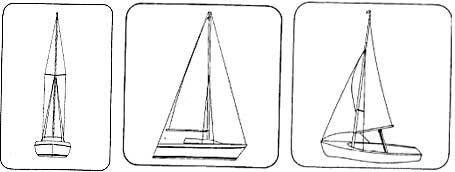
ADJUSTING SHROUDS
It is most important not to have sideways curve in your mast. The mast should be as straight as possible.
To achieve this, it is best to have the upper shrouds leading to the upper part of the mast taut, and the lower shrouds somewtiat slack. More masts are lost due to improper tuning of the shrouds than for any other reason. It is better to have the whole mast straight and lean sideways slightly under sail, than to have it twisting sideways.
The reason for taut upper and slack lower shrouds is because of the linear stretch of the rigging wire. The uppers being longer will stretch more than the shorter lowers. Hence, if the lower shrouds are equally taut, a sideways curve is inevitable.
Again on the smaller daysailers with a simple three-stay rig, the shrouds do not go to the mast head, and it is only necessary to keep these single shrouds as tight as possible.
We now have the fore and aft stays taut and the tuning theory to keep your mast straight.
PROPER RIGGING OF THE MAST
To achieve balance, the mast must be raked properly. Masts are usually set up either straight up and down or raked slightly aft. If the boat has lee helm, try raking the mast aft more; if she has excessive weather helm, reduce the amount of the rake, or even try raking it forward until better balance is achieved. Preliminary adjustments should be made at anchor or before launching. After the boat is under sail, sight up along the mast to see how it stands Adjust the turnbuckles to correct and sight again, repeating the process until the mast is straight. Be careful not to overtighten. Loosening the lowers can often accomplish more than over tightening the uppers. If shrouds are made too tight, the mast has added compression stress, is more apt to break, and is prone to bow into worse curves than existed before adjusting began.
Mast rake becomes less critical on the smaller daysailers in that balance can often be more readily changed by changing the centreboard position and moving crew weight, than by altering mast rake, and where mast rake is required to be altered, it is relatively simple to do so with only three stays. If the mast is moved, then the principles we have described, will apply.
Once your boat is tuned the way she sails best, mark your turnbuckle settings with a daub of paint so when rerigging you will know your adjustments. In time your rigging may stretch so you will have to take it up slightly.
We summarize (5/32 SS):
1. Keep the head and backstay tight (3.5% - Loos#19).
2. Keep your upper shrouds tight (9.5% - Loos#29) and lowers a little slack (6.5% - Loos#25).
3. Adjust your shrouds so your mast is straight under sail, even though the mast may lean to leeward slightly.
4. Adjust the head and backstay so the mast is straight up and down or raked slightly aft.
5. Adjust as necessary for correct balance.
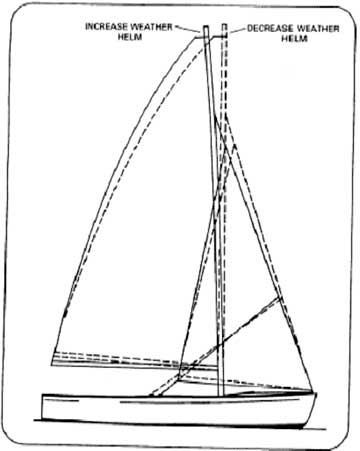
TO DECREASE WEATHERHELM
1. STEP MAST FURTHER FORWARD.
2. DECREASE RAKE OF MAST.
3. MOVE CREW & GEAR (WEIGHT) FURTHER AFT.
4. SAIL BOAT MORE UPRIGHT.
5. INCREASE SIZE OF JIB.
TO INCREASE WEATHER HELM
1. STEP MAST FURTHER AFT.
2. INCREASE RAKE OF MAST.
3. MOVE CREW & GEAR (WEIGHT) FURTHER FORWARD.
4. SAIL BOAT AT GREATER ANGLE OF HEEL.
5. DECREASE SIZE OF JIB.
GET SET FOR MAXIMUM PERFORMANCE
Having now correctly set the mast and rigging on your boat, the power is applied to the rig through the correct tuning and setting of the sails. In order to give you a thorough understanding of this important question, we are enclosing with this presentation the Neil Pryde publication “Get Set For Maximum Performance”. Read this carefully and follow the advice given, and we are sure you will obtain maximum satisfaction from your O’Day sailboat.
SAIL CARE
The life of your O’Day sails depend largely on how they are used and maintained.
PREVENTIVE CARE
Be sure that no sharp objects from your rigging come into contact with the sails. Tape up any sharp edges on spreader tips, turnbuckles, or other items of equipment, so there are no sharp edges which can tear sails.
Polyester and Nylon are sensitive to ultra-violet light. You should avoid leaving Polyester and Nylon sails exposed to direct sunlight for a long period of time. Nylon is especially sensitive to this deterioration. If you leave your mainsail stowed on the boom, be sure to have it properly covered with a sail cover. Under no circumstances leave your spinnaker lying in an area where it is directly exposed to sunlight.
When either dyed Nylon or dyed Dacron sail fabrics are stored wet, the color will bleed or transfer from the colored to the white, or even from a darker’shade to a lighter shade. The wetter and more compressed the fabric, the greater the bleeding - such as stuffed in a sailbag.
To prevent color transfer on your sails, dry them as thoroughly as possible after using. Try not to store wet in sailbag any longer them than necessary.
CLEANING SAILS
Because of the sheer size of the average sail and the manner in which they are used, it is practically impossibly to prevent sails from becoming slightly soiled or stained in use. Once stained, it is extremely difficult to clean the sail so as to return it to its original condition.
Over the years, we have noticed many owners have made the mistake of regularly washing their sails with soap and water after use, in the misguided hope that they are maintaining their sails in perfect condition. This is a mistake!
Polyester sailcloth is finished with various types of resin coatings to give it the slick, zero porosity finish which is essential to maximum performance. Constant washing and scrubbing with soap and detergent eventually breaks down these resins and removes this all-important surface. In our opinion, it is better to accept the off-white appearance of a well-used sail than a pure-white lifeless piece of cloth.
When sailing in salt water, salt deposits will build up on sails of both Polyester and Nylon making them stiffer and less pliable to handle. With light-weight Nylon fabric, this salt adds weight which is a noticeable disadvantage. The simplest way to remove salt deposits is to hose the sail down with a high pressure hose while the sail is hanging and let it dry draped over the boom, or set up on the boat only just long enough to dry but to avoid extreme exposure to sunlight.
We definitely do not recommend scrubbing and washing sails with detergents, soap and water on a regular, frequent basis.
Once or twice a season you can remove surface dirt from the sails by washing them with household soap or detergent and water. Usually soaps and detergents are alkaline so after washing, the sails should be rinsed four or five times in clear fresh water to remove the cleaning agent from the cloth completely. Again, we would emphasize that this should not be a regular and frequent process. Once or twice a season is maximum!
If the sails become stained by oil, grease, tar, or similar products, these stains can safely be removed by immersing the stained parts of the sail in a solvent, such as white spirits or a petroleum-based paint thinner. These will not harm the sail. Certain stains, such as blood, may be removed by using a bleaching agent; but after the stain has been removed, the sail must be thoroughly washed in fresh water to remove the bleaching agent completely from the sailcloth.
Again, we would emphasize that the life expectancy and performance of your sail will be prolonged more by protecting the finish on the fabric, than by keeping a pure-washed surface on the sail.
STORAGE OF SAILS
After the sails have been dried they should be folded and stored in the sailbag. Folding sails is a skill which for some reason yachtsmen seldom seem to acquire. For the sake of simplicity we are illustrating below the correct method of folding sails.
 1. Spread the sail flat |
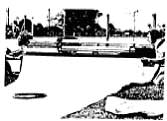 2. Start at foot and fold over window first. Continue folding in panels like a road-map. |
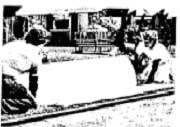 3. Keep tension on folds with both sets of hands. |
 4. Width of each fold should be slightly shorter than length of sail bag. |
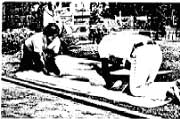 5. Continue folding until entire sail flaked down. |
 6. As size of folds decreases, bolt rope will lie flat. |
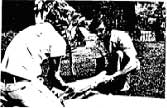 7. Fold both ends towards middle of sail. |
 8. Sail can now be rolled or folded into rectangular shape. |
 9. Place sail bag horizontally and slide in folded sail. (Folds will telescope out by gravity if inserted vertically). |
Note: The head, clew and tack patches will never be folded if folds are arranged correctly.

